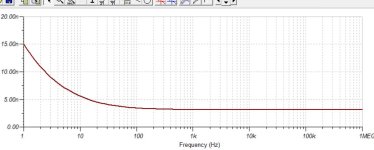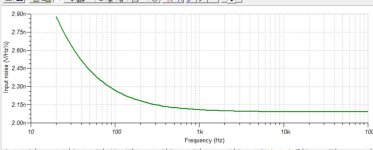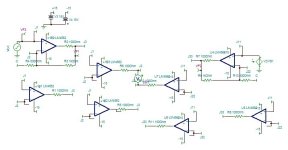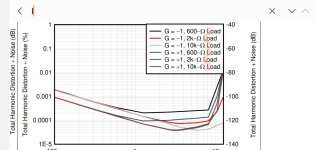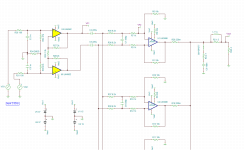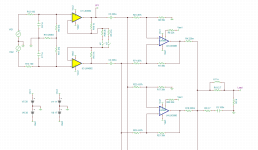H
HAYK
On high power you are getting 2nd harmonics. It can be that because the loads of the LM4562 are mismatched. One is loaded 2k/2=1k and the other 2k+20k=22k.
Assuming the noise sources are completely uncorrelated.If 2 3886 are paralleled, the noise is decreased by sqrt 2 to become 500uv.
Tom
H
HAYK
The load difference I mean that of the LM4562 outputs. In my version, I have the U3 loaded 600 ohms, 2k+400/2=1.2k. 1.2k/2 because 2 chips paralleled =600.
U4 is loaded 2k+400+4k=6.4k. 6.4k/2=3.2k.
I need to add a resistor R18=738 (750) extra load to get also 600 ohm loaded.

In your case, one is loaded 500 ohms the other 11k. You need to add a resistor 560 ohm.
U4 is loaded 2k+400+4k=6.4k. 6.4k/2=3.2k.
I need to add a resistor R18=738 (750) extra load to get also 600 ohm loaded.
In your case, one is loaded 500 ohms the other 11k. You need to add a resistor 560 ohm.
For my four paralleled I used 39k and 4.87k resistors around lm3886.
Does that mean 4.87/4 = 1.22k and (4.87+39)/4 = 10.9k?
Does that mean 4.87/4 = 1.22k and (4.87+39)/4 = 10.9k?
Last edited:
H
HAYK
No it isn't. Each 4.87k on - input has 2x the opamp voltage, it loads twice. By this on one side you have 600 ohms loaded, the other 11k. You need to load it with 680ohm more.
Last edited by a moderator:
H
HAYK
It is possible to stack pile 4 lm4562 dip8 and divide all your resistors by 4. It can result noise reduction by 4 fold as 4.8k input resistors are the major noise generators. As you are using the 4562 at low outputs, the noise is dominant, by paralleling 4, the noise gets reduced by 6db.
Stacking opamps give the same output offset problems as with the LM3886 power amps, thus you need some resistors in the outputs.
Noise has been reduced in op-amps by using sets of paralleled transistors making up a long-tailed pair for the input, effectively replacing the on-chip long-tail pair. There was a device specifically for this purpose, LM194/LM394 that was a bunch of transistors on a die wired up as two transistors, currently available from another manufacturer as AS394.See AN-222 p.433 here:
https://www.researchgate.net/profil...ductorLinearApplicationsHandbook1994_text.pdf
Noise has been reduced in op-amps by using sets of paralleled transistors making up a long-tailed pair for the input, effectively replacing the on-chip long-tail pair. There was a device specifically for this purpose, LM194/LM394 that was a bunch of transistors on a die wired up as two transistors, currently available from another manufacturer as AS394.See AN-222 p.433 here:
https://www.researchgate.net/profil...ductorLinearApplicationsHandbook1994_text.pdf
H
HAYK
Many use multiple opamps in DACs stacked as I/V converter as 8xad844 for example. There are power amps made of a huge number of paralleled opamps without any resistor. Personally I have never tried any.
I see the open loop impedance of 4562 is 13 ohms, 100 ohms on each output can be better. The 5534 has 2k impedance.
I see the open loop impedance of 4562 is 13 ohms, 100 ohms on each output can be better. The 5534 has 2k impedance.
Last edited by a moderator:
H
HAYK
Attachments
H
HAYK
Now, the 3886 is driven with 600 ohms sources. If one 3886 is used the output noise is 44uv A weighted for a gain of 21, approximately 80uV non weighted, with a gain of 3.33, it will be reduced to 12uV + 6uV from the opamps =18uV.
80÷18=4.4 better than 3886 alone. If quadruple 3886 reduces also min 1.4 times =6 times minimum better.
80÷18=4.4 better than 3886 alone. If quadruple 3886 reduces also min 1.4 times =6 times minimum better.
What about noise of OPA1656? cmos inputs are supposed to be less noisy? and it’s twice current drive of lm4562
also open loop gain is higher
also open loop gain is higher
I don’t understand, why loading symmetrically is needed in the first place? both lm4562 and opa1656 that i’m using are capable of driving 600r and 11k no problemNo it isn't. Each 4.87k on - input has 2x the opamp voltage, it loads twice. By this on one side you have 600 ohms loaded, the other 11k. You need to load it with 680ohm more.
H
HAYK
The distortion with 600 ohms has different harmonics than with 11k. Only when they are symmetrical that even ones get subtracted in differential mode.
You can see on the graphs how 600 ohm and 10k distortion diverge above 700mv.
Talking about noise, the 4562 has 6.4nv vs 32nv at 10hz. As you are using differential low impedance source, you don't need jfet which is exampt of current noise, it would be beneficial if you were using single ended with a potentiometer.
I was wrong with the noise reduction of multiple paralleled opamps. I am comparing a single opamp vs 2x4. By adding a second input, I double the noise source and by quadruple I decreased it back, this proves that quadruple 3886 must decrease the noise by 6db.
Your bottleneck now are these 4.86k ones that are noise generators. 4 of them are already loading 500 ohms, to have 600 ohms instead of 4.87k you will need to increase the output possibility of the opamps, maybe adding buffer.
You can see on the graphs how 600 ohm and 10k distortion diverge above 700mv.
Talking about noise, the 4562 has 6.4nv vs 32nv at 10hz. As you are using differential low impedance source, you don't need jfet which is exampt of current noise, it would be beneficial if you were using single ended with a potentiometer.
I was wrong with the noise reduction of multiple paralleled opamps. I am comparing a single opamp vs 2x4. By adding a second input, I double the noise source and by quadruple I decreased it back, this proves that quadruple 3886 must decrease the noise by 6db.
Your bottleneck now are these 4.86k ones that are noise generators. 4 of them are already loading 500 ohms, to have 600 ohms instead of 4.87k you will need to increase the output possibility of the opamps, maybe adding buffer.
Attachments
Last edited by a moderator:
Yeah those 4.87k resistors are the lowes I think I can go. I like your idea of using capacitors for low pass filtering between chips. It allows to use lower values resistors
H
HAYK
I have had some fun in simulator playing with both my original version and that what @HAYK suggested.
I was able to lower down the noise from 8.8u to 2.3u and it is improvement about 11dB.
I was not able to screenshot another two paralleled LM3886 but they are there. So it is four in parallel.
Both cases are for balanced inputs.
Attached sim files.
I was able to lower down the noise from 8.8u to 2.3u and it is improvement about 11dB.
I was not able to screenshot another two paralleled LM3886 but they are there. So it is four in parallel.
Both cases are for balanced inputs.
Attached sim files.
Attachments
Last edited:
Yeah it looks like there still room for improvement for Modulus amp - potentially noise performance.
Just different approaches to the same result. Probably sounds different too.
Regarding the schematic, how does it work? why just adding two resistors and cap changes things so drastically?
noise gain is determined by 1k and 10k resistors, right? Or 10/1 = 10x ?
So what is the actual gain for the signal? 10k /(6.2+1) = 1.38x ?
also for loading outputs for lm4562,
one is 6.2+1)/2 = 3.6
3.6/ 4 parallel = 0.9kohm
and second is 6.2+1+10 = 17.2 / 4 = 4.3kohm
is it correct?
thank you!🙏
Just different approaches to the same result. Probably sounds different too.
Regarding the schematic, how does it work? why just adding two resistors and cap changes things so drastically?
noise gain is determined by 1k and 10k resistors, right? Or 10/1 = 10x ?
So what is the actual gain for the signal? 10k /(6.2+1) = 1.38x ?
also for loading outputs for lm4562,
one is 6.2+1)/2 = 3.6
3.6/ 4 parallel = 0.9kohm
and second is 6.2+1+10 = 17.2 / 4 = 4.3kohm
is it correct?
thank you!🙏
Last edited:
Regarding the schematic, how does it work? why just adding two resistors and cap changes things so drastically?
noise gain is determined by 1k and 10k resistors, right? Or 10/1 = 10x ?
So what is the actual gain for the signal? 10k /(6.2+1) = 1.38x ?
also for loading outputs for lm4562,
one is 6.2+1)/2 = 3.6
3.6/ 4 parallel = 0.9kohm
and second is 6.2+1+10 = 17.2 / 4 = 4.3kohm
is it correct?
thank you!🙏
I would appreciate if someone can double check my calculations above, thanks!
Also, is there tda7293 sim model at all?
I wonder if the solution @HAYK offered will work for that chip?
- Home
- Amplifiers
- Chip Amps
- Another LM3886 in parallel attempt - this time 4 of them!
